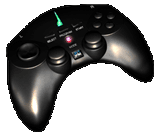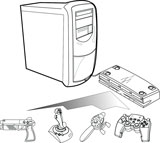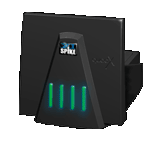At E3 2000 Airplay left us impressed. Their
demo of wireless RF controllers inspired dreams of gaming without a tether. Finally, we
hoped that videogames would truly enter the future. High polygon counts and SurroundSound
audio is an expected evolution for gaming, but we know that the next major breakthrough
for any technology is to go wireless. Wireless phones, wireless Internet, and wireless
gaming is the horizon we can now envision clearly, and the folks who brought us Airplay,
Eleven Engineering, have made things a little bit clearer.
 Eleven Engineering is a Canadian
company that has been working on wireless RF technology for the past several years. They
developed, manufactured, released, distributed, and promoted their first product, Airplay,
all by themselves, making them suitably punk for us. Seizing on a good idea, they chose
the DIY route, and it worked. The Airplay controller for PlayStation was an almost perfect
creation, and far outpaced any wireless controller to come before it. But Eleven
Engineering wasn’t content to just continue with their smallish penetration in the
market. Maybe they realized that if they kept doing what they were doing, they would
eventually lose out to the might of larger companies who could copy their product. Maybe
they just have a bent for total industry domination. That’s the road their heading
down with their latest project, Spike.
Eleven Engineering is a Canadian
company that has been working on wireless RF technology for the past several years. They
developed, manufactured, released, distributed, and promoted their first product, Airplay,
all by themselves, making them suitably punk for us. Seizing on a good idea, they chose
the DIY route, and it worked. The Airplay controller for PlayStation was an almost perfect
creation, and far outpaced any wireless controller to come before it. But Eleven
Engineering wasn’t content to just continue with their smallish penetration in the
market. Maybe they realized that if they kept doing what they were doing, they would
eventually lose out to the might of larger companies who could copy their product. Maybe
they just have a bent for total industry domination. That’s the road their heading
down with their latest project, Spike.
Riddle me this, dear reader: Bluetooth technology allows wireless communication that is
reliable and robust over huge distances. It’s ideal for cell phones and maintaining
your laptop Internet connection, not to mention static applications such as remote cameras
in non-wired environments. The performance of Bluetooth is great, but the cost has been
prohibitive, resulting in a very slow trickle of the technology into affordable
applications. So while Bluetooth is great, it’s also very expensive, and simple
questions of practicality come into play: Why do you need a wireless method of information
transfer that will reach for miles and miles when you’re just sitting ten feet away
from your console system? Or why would you need all the power of Bluetooth, when the
computers on your home network are all within 50 feet of each other? The answer is simple:
You don’t.
Spike is a new wireless protocol involving specific, custom hardware, that does not
provide the range of a Bluetooth device, but comes at a much lower cost. Eleven
Engineering feels that this better level of cost-efficiency, coupled with the high
reliability of Spike, will make it ideal for home or local area wireless solutions. And
they’re right as far as we can tell.
To prove themselves, and, we suspect, remaining true to their roots as gamers, Eleven
Engineering is first incorporating Spike into gaming applications, namely wireless
controllers. This makes sense for one big reason: Gaming offers you no chance to screw up.
There is no way to look the other direction when your wireless controller makes you walk
your character off a ledge or blow that final boss battle. Bugs like these will elicit
immediate retribution on the part of the gaming community. Game controllers require
constant communication with the console or PC – signals controlling force feedback
stream constantly to the controller, while joystick movements and button taps flow
interminably back to the system. Without completely reliable two-way communication, a
controller cannot function. This is very different than the reliability that is required
with a TV remote. The reason we’ve been able to tolerate infra-red remote controls
for so long is that they are much simpler – there is no need for a constant
connection, and the information only flows from the remote to the receiver. If Spike can
conquer the videogaming world, then other home wireless applications should fall like so
many lined up dominoes.
Spike could make a strong opening salvo as early as this fall, although product
launches in early next year are more likely. Eleven Engineering has negotiations in
progress with all the major third-party peripherals manufacturers, although the biggest
news right now is RCA’s interest in the technology to form a foundation of their new
line of controllers. Spike controllers will be released for every console platform and
PCs. But that’s just the beginning. Here’s how things will work:
 Getting
your system all Spiked out will require the purchase of a transceiver and at least one
controller. You will be able to get a OneX or QuadX transceiver; the former supports a
single controller (ideal for PCs), while the latter supports up to four controllers (say
goodbye to your multi-tap). Once you’ve purchased the transceiver, any Spike enabled
controller can be used with it. That means you’ll be able to get your Spike light gun
and fishing controller out whenever you need to, but that’s not the exciting news.
Spike will allow you to use any system’s controller with any other system. You like
those Dual Shock 2 controllers, right? Of course you do. So why not use your Spike enabled
DS2 controller on your Xbox? Or your GameCube? The Spike transceiver automatically takes
care of key-mapping to allow you to use any Spike enabled controller from any gaming
system on any other gaming system. That means you can hone your skills on whatever comfy
controller design you like best, and you won’t have to switch up your style because
your buddy has a different system.
Getting
your system all Spiked out will require the purchase of a transceiver and at least one
controller. You will be able to get a OneX or QuadX transceiver; the former supports a
single controller (ideal for PCs), while the latter supports up to four controllers (say
goodbye to your multi-tap). Once you’ve purchased the transceiver, any Spike enabled
controller can be used with it. That means you’ll be able to get your Spike light gun
and fishing controller out whenever you need to, but that’s not the exciting news.
Spike will allow you to use any system’s controller with any other system. You like
those Dual Shock 2 controllers, right? Of course you do. So why not use your Spike enabled
DS2 controller on your Xbox? Or your GameCube? The Spike transceiver automatically takes
care of key-mapping to allow you to use any Spike enabled controller from any gaming
system on any other gaming system. That means you can hone your skills on whatever comfy
controller design you like best, and you won’t have to switch up your style because
your buddy has a different system.
 This is a major breakthrough for several reasons. The biggest is just a cost
factor. Controllers cost a lot of money. It’s frustrating to not be able to enjoy a
full-on four player brawl because you don’t have enough controllers. And with the
proliferation of new systems this year, gamers are going to make tough choices about what
system they want to deck out. Do you get four controllers for your Xbox, PS2, or GameCube?
Getting controllers for each would equal the cost of buying a new TV or that DTS receiver
you’ve been wanting. However, if you, and your buddies, each had only one Spike
enabled controller, the problem would be solved. This kind of cross-platform compatibility
is welcomed, especially in a market that is growing beyond system exclusivity every day.
With Sony’s recent talk about the PS3, and how they plan to let all companies (even
Microsoft and Nintendo) release games for the system, it just becomes more apparent that
titles will be available for every platform at ever-increasing rates. Already we’ve
seen dozens and dozens of titles come out for every platform. Multi-platform game releases
have also allowed game publishers to recoup their investments in games easier, which in
turn allows publishers to invest more money in game development. Cross-platform
compatibility is a sign of the times, and indicative of the gaming world we hope to see
develop.
This is a major breakthrough for several reasons. The biggest is just a cost
factor. Controllers cost a lot of money. It’s frustrating to not be able to enjoy a
full-on four player brawl because you don’t have enough controllers. And with the
proliferation of new systems this year, gamers are going to make tough choices about what
system they want to deck out. Do you get four controllers for your Xbox, PS2, or GameCube?
Getting controllers for each would equal the cost of buying a new TV or that DTS receiver
you’ve been wanting. However, if you, and your buddies, each had only one Spike
enabled controller, the problem would be solved. This kind of cross-platform compatibility
is welcomed, especially in a market that is growing beyond system exclusivity every day.
With Sony’s recent talk about the PS3, and how they plan to let all companies (even
Microsoft and Nintendo) release games for the system, it just becomes more apparent that
titles will be available for every platform at ever-increasing rates. Already we’ve
seen dozens and dozens of titles come out for every platform. Multi-platform game releases
have also allowed game publishers to recoup their investments in games easier, which in
turn allows publishers to invest more money in game development. Cross-platform
compatibility is a sign of the times, and indicative of the gaming world we hope to see
develop.
 In addition to the handiness of allowing for universally compatible
controllers, Spike gives us wireless gaming. Using RF technology (that’s radio waves
for the non-techies out there), it is unblockable, except by maybe lead shielding.
That’s critical to maintaining communication between the game system and controller.
The signal is strong for 30 feet, giving gamers an unprecedented break from either sitting
on the floor or dragging their system halfway across the living room. That might also
prevent your buddy from stepping on the unit when he makes that mad dash for more Mountain
Dew and Doritos. In addition to supporting four players on one transceiver, Spike also
allows up to 16 controllers to be used in the same vicinity with no interference. Given
that Halo will allow you to play four on four matches, you could have 15 of your closest
friends, four TVs, and four Xbox systems in your living room at once, and nobody would
have to trip over a cord. If I had a nickel for every time I have 16 gamers playing at
once in my house, I’d be a poor, poor man. But the point here is that Spike makes it
possible, and possibility is good.
In addition to the handiness of allowing for universally compatible
controllers, Spike gives us wireless gaming. Using RF technology (that’s radio waves
for the non-techies out there), it is unblockable, except by maybe lead shielding.
That’s critical to maintaining communication between the game system and controller.
The signal is strong for 30 feet, giving gamers an unprecedented break from either sitting
on the floor or dragging their system halfway across the living room. That might also
prevent your buddy from stepping on the unit when he makes that mad dash for more Mountain
Dew and Doritos. In addition to supporting four players on one transceiver, Spike also
allows up to 16 controllers to be used in the same vicinity with no interference. Given
that Halo will allow you to play four on four matches, you could have 15 of your closest
friends, four TVs, and four Xbox systems in your living room at once, and nobody would
have to trip over a cord. If I had a nickel for every time I have 16 gamers playing at
once in my house, I’d be a poor, poor man. But the point here is that Spike makes it
possible, and possibility is good.
 The
one problem with the Airplay was the antenna on the transceiver. It was a limp piece of
wire that had to be taped or pinned to my entertainment center in order to work. It
wasn’t pretty, but it did work well. Spike solves that problem with much more robust
transceivers that have better antennas built in. There will be no futzing around with the
antenna in order to secure your connection.
The
one problem with the Airplay was the antenna on the transceiver. It was a limp piece of
wire that had to be taped or pinned to my entertainment center in order to work. It
wasn’t pretty, but it did work well. Spike solves that problem with much more robust
transceivers that have better antennas built in. There will be no futzing around with the
antenna in order to secure your connection.
We’re excited about the potential of Spike, and the reputation of Eleven
Engineering, their dedication to the product, and their hard-working DIY ethic should only
help seal the new protocol’s success. Once the technology is ironed out to gaming
standards, it will begin to migrate to many other home and local area applications. Spike
could work in a USB hub, allowing not only simple plug-and-play connections, but wireless
devices. With the power built into game systems of today, it isn’t unreasonable to
assume that in a year or two we’ll be using the Xbox or PS2 for more than simple
gaming, and Spike technology will be there to help us network. Nobody can predict exactly
what kinds of products and peripherals will pick up on Spike, but Eleven Engineering and
the crew have already done their job. They’ve offered us a whole world of
possibility, and that’s all we can really ask for.
